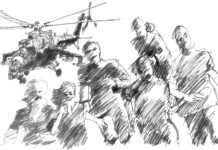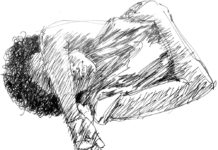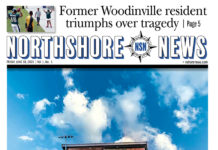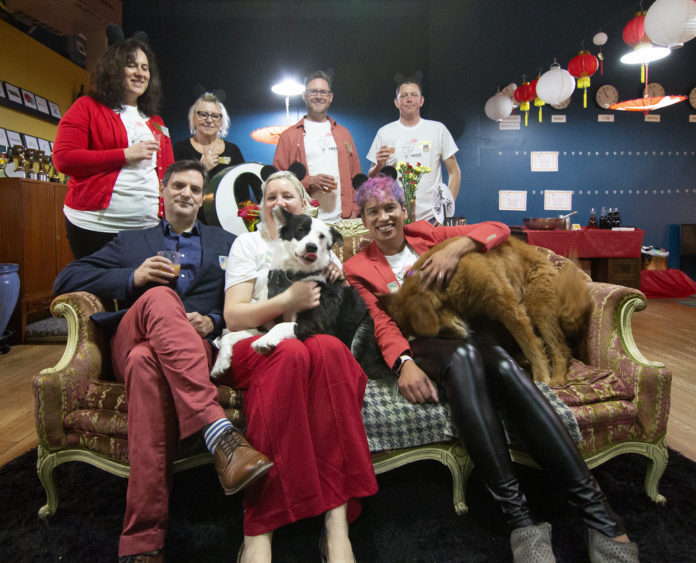The Quesinberry & Associates team, seated from left, Todd Christensen, Wendy Quesinberry (with Hank) and Alfredo Biralde III (with Lola); standing, Jen Hill and freelancers Lauri Sinard-Tomas, Scott Schmehl and Brendan Bigley.
By Wendy Quesinberry
“I don’t know what will happen moving forward. But I’m proud of my neighborhood and I’m hopeful that this is just the start of real change.” That’s how I ended my June 15 article. It’s been three months and while lots has happened, I’m still hoping for real change.
I stopped working from home on June 8, going in to the office weekdays and most weekends. My building is adjoined to the East Precinct. I never once had a problem getting in or out of my office during CHOP. Not even when it became concentrated into the one block between Pike and Pine—the block I work on. After the police reclaimed the East Precinct on July 1, I received emails and texts asking if I was “happy to have my block back.” I replied that the only time I had to ask permission to get to my building was before and after CHOP.
I’ve been frustrated by much of the media coverage about CHOP and this neighborhood. Some reports have gotten the facts wrong, some only show a small piece of a bigger story. I was told that crime was going to increase anywhere from 500% to 5,000% during CHOP. According to the SPD’s Crime Dashboard, the total number of offenses reported by the East Precinct for the month of June (and the entirety of CHOP) was 489. For comparison, the total number of offenses reported by the East Precinct during the same time last year, June 2019, was 459. In June of 2018, the total was 485.
There’s no dispute that things were different at night, I certainly didn’t hang out after 10 p.m. And the attacks directed at the East Precinct did not help the movement. As a result, we now have a closed-off fortification on the corner of 12th and Pine. Not only is it an eyesore, but it doesn’t feel like SPD is part of this community any longer. You can’t walk into the lobby and talk to them. You don’t see police officers walking in and out of the precinct. They are just the enforcers who come speeding out of the garage when calls come in.
The parks department “closed” Cal Anderson at the beginning of the month. This didn’t mean people couldn’t go into the park, it just meant that the volunteers trying to help the homeless couldn’t use the public buildings any longer. They had set up a base at the park’s two central buildings to store donations, feed people, and to find necessary resources to help. The multiple sweeps by police and eventual fencing off of the public buildings just seemed cruel. We’ve forgotten that these are people who need help, not our disdain.
Throughout the entire Summer, Cal Anderson has been the hub for protesters, the homeless and their advocates, as well as friends gathering for a social-distance picnic and dogs frolicking off leash. When I hear reports that this neighborhood is in crisis (presumably because of the protests and homeless encampments) I want to hear more than a sound bite, because it’s not mapping back to the resiliency I see daily.
The neighborhood is doing its best to keep things going. One of the biggest draws—live music—is still not an option. But restaurants are taking advantage of the new regulations that allow for outdoor seating on the street, giving the opportunity to fill more tables, which they do. And for the little shops that have been able to hang on during the pandemic, it seems that more people are ready to shop.
I’m still proud of my neighborhood. I still don’t have a sense if there’s going to be real change, but I still hope there will be.
Wendy Quesinberry is the principal of Quesinberry and Associates (aka Q&A). You can contact her at wendyq@quesinberry.com.







Thanks for your update and observations Wendy. I love your even handed reporting. I’ve always felt a strong connection to your neighborhood. My first office was on your block back in my Burnley School days. Like you I’m saddened by the cities handling of the homeless. Cutting off use to bathrooms and parks just seems wrong to me. Back in the Hooverville days (1930s) the city, police and the business community all helped by providing resources and ultimately jobs to the residents of our Hooverville. Seem to me like we should be doing that now. Not just shutting them out and moving them along.
Comments are closed.